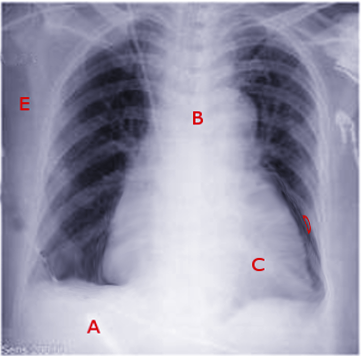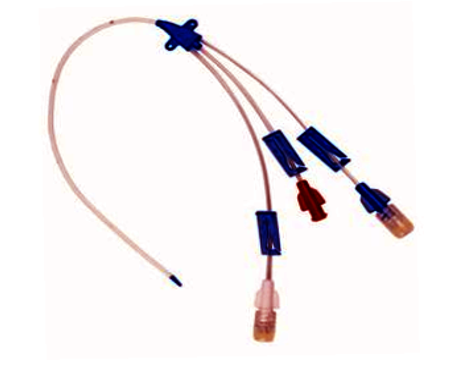[1]
Korsten P, Mavropoulou E, Wienbeck S, Ellenberger D, Patschan D, Zeisberg M, Vasko R, Tampe B, Müller GA. The "rapid atrial swirl sign" for assessing central venous catheters: Performance by medical residents after limited training. PloS one. 2018:13(7):e0199345. doi: 10.1371/journal.pone.0199345. Epub 2018 Jul 16
[PubMed PMID: 30011285]
[2]
Najari F, Amirian M, Sadjadi S, Baradaran Kayal I. Loss of Guide Wire as an Important Complication of Central Venous Catheterization; a Case Report. Emergency (Tehran, Iran). 2018:6(1):e17
[PubMed PMID: 30009219]
Level 3 (low-level) evidence
[3]
Björkander M, Bentzer P, Schött U, Broman ME, Kander T. Mechanical complications of central venous catheter insertions: A retrospective multicenter study of incidence and risks. Acta anaesthesiologica Scandinavica. 2019 Jan:63(1):61-68. doi: 10.1111/aas.13214. Epub 2018 Jul 11
[PubMed PMID: 29992634]
Level 2 (mid-level) evidence
[4]
Silvetti S, Aloisio T, Cazzaniga A, Ranucci M. Jugular vs femoral vein for central venous catheterization in pediatric cardiac surgery (PRECiSE): study protocol for a randomized controlled trial. Trials. 2018 Jun 25:19(1):329. doi: 10.1186/s13063-018-2717-1. Epub 2018 Jun 25
[PubMed PMID: 29941012]
Level 1 (high-level) evidence
[5]
Mahabadi N, Goizueta AA, Bordoni B. Anatomy, Thorax, Lung Pleura And Mediastinum. StatPearls. 2023 Jan:():
[PubMed PMID: 30085590]
[7]
Hojsak I, Lacaille F, Gupte GL, Köglmeier J. Central Line in Long-term Parenteral Nutrition in Children: A European Survey. Journal of pediatric gastroenterology and nutrition. 2018 Sep:67(3):409-413. doi: 10.1097/MPG.0000000000002064. Epub
[PubMed PMID: 29916949]
Level 3 (low-level) evidence
[8]
Lambert I, Tarima S, Uhing M, Cohen SS. Risk Factors Linked to Central Catheter-Associated Thrombosis in Critically Ill Infants in the Neonatal Intensive Care Unit. American journal of perinatology. 2019 Feb:36(3):291-295. doi: 10.1055/s-0038-1667377. Epub 2018 Aug 6
[PubMed PMID: 30081400]
[9]
Paik P, Arukala SK, Sule AA. Right Site, Wrong Route - Cannulating the Left Internal Jugular Vein. Cureus. 2018 Jan 9:10(1):e2044. doi: 10.7759/cureus.2044. Epub 2018 Jan 9
[PubMed PMID: 29541565]
[10]
Soffler MI, Hayes MM, Smith CC. Central venous catheterization training: current perspectives on the role of simulation. Advances in medical education and practice. 2018:9():395-403. doi: 10.2147/AMEP.S142605. Epub 2018 May 25
[PubMed PMID: 29872360]
Level 3 (low-level) evidence
[11]
Arafa R, Khammas H, Agrawal A. Guidewire-induced asystole complicating a right internal jugular catheter placement in a patient with pre-existing left bundle branch block: A case report. The journal of vascular access. 2019 Mar:20(2):217-221. doi: 10.1177/1129729818783966. Epub 2018 Jul 9
[PubMed PMID: 29984628]
Level 3 (low-level) evidence
[12]
Amir R, Knio ZO, Mahmood F, Oren-Grinberg A, Leibowitz A, Bose R, Shaefi S, Mitchell JD, Ahmed M, Bardia A, Talmor D, Matyal R. Ultrasound as a Screening Tool for Central Venous Catheter Positioning and Exclusion of Pneumothorax. Critical care medicine. 2017 Jul:45(7):1192-1198. doi: 10.1097/CCM.0000000000002451. Epub
[PubMed PMID: 28422778]
[13]
Weekes AJ, Keller SM, Efune B, Ghali S, Runyon M. Prospective comparison of ultrasound and CXR for confirmation of central vascular catheter placement. Emergency medicine journal : EMJ. 2016 Mar:33(3):176-80. doi: 10.1136/emermed-2015-205000. Epub 2015 Oct 7
[PubMed PMID: 26446313]
[14]
Cleff C, Boensch M, Eifinger F, Hinkelbein J. [Correct positioning of central venous catheters in pediatrics : Are current formulae really useful?]. Der Anaesthesist. 2018 Jul:67(7):519-524. doi: 10.1007/s00101-018-0446-1. Epub
[PubMed PMID: 29736556]


